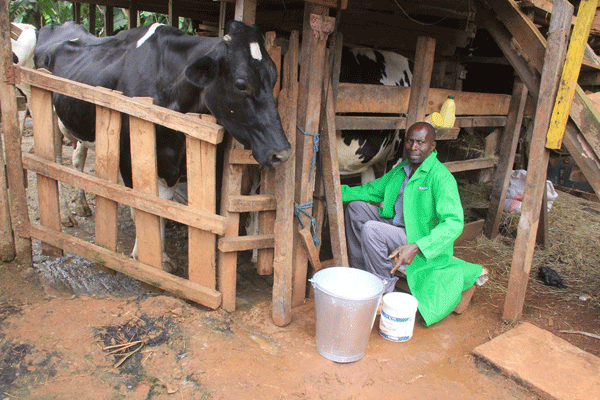Clad in a green overcoat and carrying a milk bucket in his right hand, Charles Njoroge marches confidently to his cow pen.
It’s about 4pm and the farmer just heard his cows’ loud moo — a sign that they should be milked.
Njoroge puts down the bucket, moves one of the cows to the milking pen and occupies a stool beside it. He washes the cow’s udder with warm disinfected water followed by his hands, which he dries on a small towel.
He starts milking the cow as nine others await their turn.
“Today I am alone. I have to milk all the nine cows by myself. Usually, I have an employee who helps me milk.”
Njoroge keeps 15 Friesian cows, five of them calves, on his 1.6-acre farm in Mukurweini, Nyeri County. He gets 210 litres of milk from nine of his cows every day. Four of the cows produce 40 litres a day because they just recently calved, while the others give between 20 and 30 litres.
“I milk the cows three times a day, but there are some that produce milk up to four times,” he tells us, momentarily turning away from his work.
Rich source of food
So what is his secret, given many farmers complain they buy cows with promise, only to milk far less than they expect?
“The secret lies in maize. I plant maize on my farm for use as animal feed.”
Green maize plants, together with the cobs, according to Njoroge, are a rich food source of food for dairy cows.
“I plant the maize and once it matures, I harvest and cut it into pieces to make silage,” he says, adding that fermenting the maize helps to increase nutrients, which translates to more milk.
Besides the maize, Njoroge has planted Calliandra and Tricandra, plants that are rich in proteins.
“I mix the plants’ leaves with grass, which is good in fibre and feed the animals after I have given them maize stocks. This helps in milk production,” says Njoroge, who is a livestock officer with Nyeri County government.
He further buys phosphorous and calcium supplements to feed the animals.
“Feeds are very important for dairy animals if one is to get good milk. This helps to reduce the chances of animals getting diseases and ensures they remain healthy.”
To breed the cows, he uses artificial insemination, which guarantees him quality animals.
“With my knowledge in agriculture, I am able to identify the best bull, whose semen I use to serve my cows.”
He tracks the lineage of every of his cows after insemination.
“Keeping the lineage helps me to ensure I avoid overusing the semen from a particular breed.”
Out of the 210 litres of milk he gets a day, he uses 60 litres to feed the calves, 30 litres is converted into yoghurt while he sells the rest to traders.
Njoroge says feeding the calves with milk helps in growth.
“It ensures the calves do not miss on important antigens and antibodies contained in their mother’s milk to fight diseases.” he says. “Feeding the cows in the first six weeks results in improved weight.”
He sells a litre of milk at between Sh35 and Sh40 while a litre of yoghurt, goes for Sh100, bringing the total of his sales from milk to Sh7,000 a day.
“I started making yoghurt because there are so many people who sell milk around, thus, prices are always low. I package the milk in different sizes.
Good money
“Yoghurt is earning me good money than fresh milk,” says Njoroge, who sells the milk at shops in Nyeri Town and Githurai in Nairobi, where his eldest son runs the outlet.
Njoroge went into farming about five years ago to lead by example.
“Here I was, teaching farmers the best agricultural practices but I was growing maize only. I used to find this odd. I then made up my mind to go into dairy farming so that I can get practical tips that I can offer farmers,” says Njoroge, who used his savings to start the business.
And nothing at his farm goes to waste. He uses a biogas recycling system that produces the gas that he uses at his home for cooking and lighting.
The sludge from the biogas system is used to boost the fertility of his maize, banana and capsicum plots.
He advises livestock farmers to use modern methods to increase productivity.
But it is not an easy ride for Njoroge who spends about Sh20,000 a month on supplements like dairy meal to maintain the high milk production.
Inseminating the cows artificially also comes with a challenge.
“Identifying the best semen from the best bull in the market is difficult. It requires a lot of research because if you err, you end up with what you do not need.”
Doris Wambui, a livestock expert at Wambugu Agricultural Training Centre in Nyeri, says dairy farmers should be keen on what they feed their animals.
“Fresh grass contains little nutrients. Napier grass, like fermented green maize plants, is rich in nutrients. Farmers who cannot get enough maize plants should chop Napier grass into small pieces for the cow. Fermented silage reduces the amount of energy a cow can spend in producing milk,” the expert says.
For mineral concentrates, she recommends maize germ meal, wheat bran, wheat pollard, rice bran, maize bran and molasses.
Wambui notes that it is important for calves to be fed on milk during the first six weeks to enhance growth.
“As calves keeps growing, the amount of milk they are fed on should be reduced so that they can start eating grass. This helps them adapt to new feeds easily.”









Kindly connect me with Charles Njoroge 0725096064.